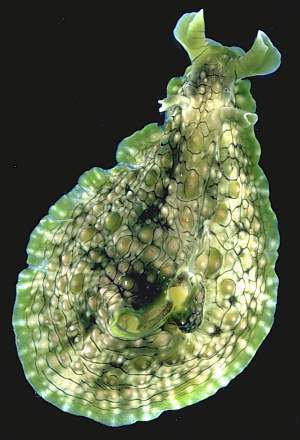
Dolabrifera brazieri
Sowerby, 1870
Order: ANASPIDEA
Superfamily: APLYSIOIDEA
Family: Aplysiidae
DISTRIBUTION
South-eastern Australia and northeastern New Zealand.
PHOTO
Two-Fold Bay, southern New South Wales, eastern Australia. March 1986 AM C149561. [animals ranged from 10-15cm long] Lower Left: showing head, Lower Right: showing opening into reduced mantle cavity. Photos: Bill Rudman
A large species of Dolabrifera often found intertidally in rock pools, and under rocks, where it lays a very recognisable egg mass, consisting of an aplysiid egg string, which instead of forming a typical aplysiid tangled mass, is attached as a flat ribbon arranged in a zigzag pattern [see photo]. It is hard and leathery to touch, with a relatively thick body wall. Although usually a mottled green, it is quite variable in colour, specimens ranging from a pale watery yellow to a dark purplish brown. Its colour provides it with very good camouflage, and it is often very difficult to see in the field. D. brazieri is a relatively large flattened Sea Hare in which the parapodia are fused to form a postero-dorsal cavity in which sits the mantle cavity. The only indication of the parapodia are the two small flaps in the posterior midline which form siphons directing an inhalent and exhalent water current in and out of the mantle cavity [lower right photo]. The body is covered in large conical tubercles which bear a white retractile branched filament at the tip [see photos in separate message]. The head [lower left photo] has the two pairs of enrolled tentacles, typical of all sea hares. The anterior pair, on either side of the mouth, are both chemosensory and tactile, being used both to 'smell' chemicals in the water, and to feel objects. The pair of tentacles behind the eyes, the rhinophores, are the main chemosensory organs, used for 'smelling' food and detecting noxious chemicals.
This large species of Dolabrifera, reaching about 15cm in length, differs from the tropical D. dolabrifera in its much larger size and the presence of the large smooth conical tubercles all over the body. It would appear to be endemic to New South Wales, in eastern Australia, and nearby waters.
See Dolabrifera shell page.
See Sea Hare shell page.
See photo of egg ribbon.
-
Allan, J. (1950) Australian Shells. Georgian House: Melbourne. 1-487.
-
Brook, F.J. (1998) The coastal molluscan fauna of the northern Kermadec Islands, southwest Pacific Ocean. Journal of the Royal Society of New Zealand 28: 185-233.
-
Hedley, C., (1917) Proceedings of the Linnean Society of New South Wales, 41: 717, Pl.49, fig. 25.
-
Sowerby, (1870) Proceedings of the Zoological Society of London, 1870: 250
-
Willan, R.C. & Morton, J.E. (1984) Cape Rodney to Okakari Point Marine Reserve. Marine Molluscs Part 2. Opisthobranchia. Leigh Marine Laboratory, University of Auckland, Auckland. 106 pages.
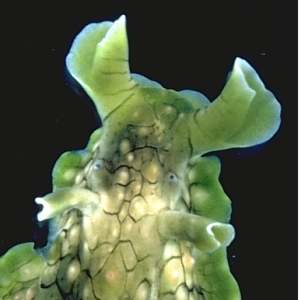
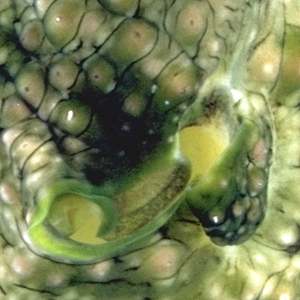
Rudman, W.B., 2003 (April 23) Dolabrifera brazieri Sowerby, 1870. [In] Sea Slug Forum. Australian Museum, Sydney. Available from http://www.seaslugforum.net/find/dolabraz
Related messages
Re: Large tubercled ?Aplysia at Little Bay, Sydney
March 19, 2010
From: Kirsten Crosby
Concerning message #23346:
Hi Bill. Yes, that looks like it. We were all most impressed the animal.
Thanks very much for the ID.
Kirsten
kirsten.crosby@gmail.com
Crosby, K., 2010 (Mar 19) Re: Large tubercled ?Aplysia at Little Bay, Sydney. [Message in] Sea Slug Forum. Australian Museum, Sydney. Available from http://www.seaslugforum.net/find/23364Sea slug? from Clovelly, Sydney
March 18, 2010
From: Eve Jary
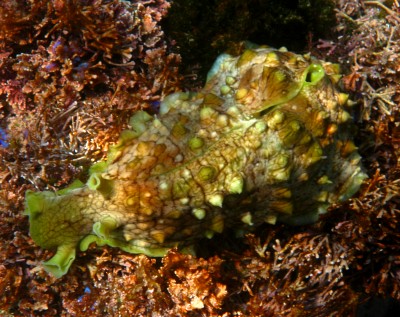
Hi,
I spotted some interesting creatures while snorkelling and am wondering if they are sea slugs (see attached picture). I'd love to know more about these strange little creatures.
Locality: Clovelly bay, Sydney,, about 1 m , New South Wales, Australia, Pacific ocean, 21st February 2010. Length: about 15 cm. Photographer: Eve Jary.
cheers,
Eve
eve_jary@yahoo.com.au
Jary, E., 2010 (Mar 18) Sea slug? from Clovelly, Sydney. [Message in] Sea Slug Forum. Australian Museum, Sydney. Available from http://www.seaslugforum.net/find/23281Dear Eve,
This is a type of Sea Slug which we call a Sea Hare. Its name is Dolabrifera brazieri. Have a look at the Fact Sheet for that species for more information
See the General Topics List for more information on Sea Hares.
Best wishes,
Bill Rudman
Dolabrifera brazieri from Mooloolaba, QLD
August 28, 2008
From: Gary Cobb
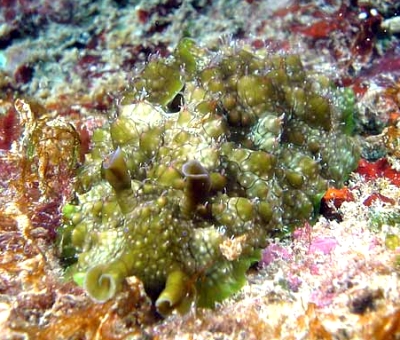
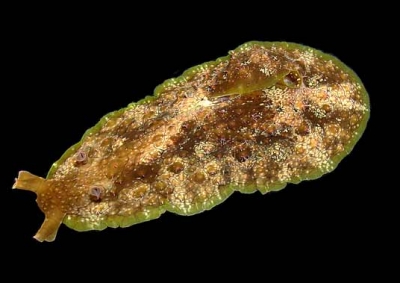
Concerning message #21824:
Hi Bill and everyone!
After reading the latest entry on Dolabrifera brazieri I thought I should send in photos of an animal we found here.
Locality: Old Woman Island, Mooloolaba, Sunshine Coast, 5m, Queensland, Australia, Pacific Ocean, 22 October 2005, Subtidal. Length: 105mm. Photographer: Gary Cobb.
PS to date we have found 347 species here on the Sunshine Coast. www.nudibranch.com.au
Cheers
Gary
gary@nudibranch.com.au
Cobb, G.C., 2008 (Aug 28) Dolabrifera brazieri from Mooloolaba, QLD. [Message in] Sea Slug Forum. Australian Museum, Sydney. Available from http://www.seaslugforum.net/find/21835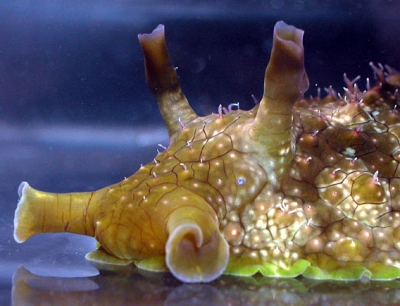
Dear Gary,
Thanks for these photos. They show the retractile papillae on each tubercle a little more spectacularly than my earlier message [#9784].
Best wishes,
Bill Rudman
Dolabrifera brazieri at Bateau Bay, New South Wales
August 22, 2008
From: Deb Gorgievski
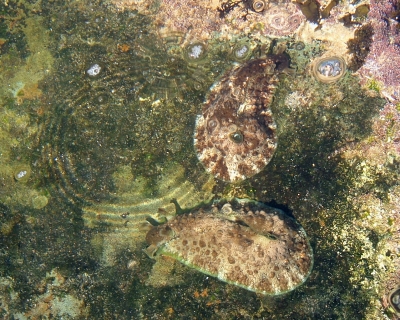
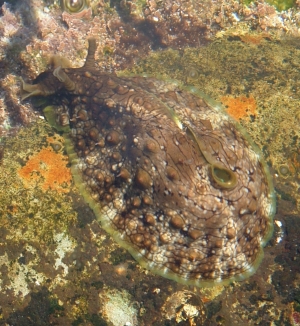
Could you please ID these for me?
These creatures were found off the edge of the Bateau Bay Rock Platform on the Central Coast of New South Wales Australia on the 22nd of March 2007. They were in 0.2m deep water on algal covered rocks just below the mean low tide mark, they appeared to be grazing. No-one touched them, so I did not see any ink. They do however appear to have the rhinophores and the oral tentacles.
Locality: Bateau Bay Rock Platform, 0.2 m, NSW, Australia, Tasman Sea, 22 March 2007, algal covered rocks. Length: 130 mm. Photographer: D.Gorgievski.
Their parapodia seems to tightly bound to their body compared to photos of Aplysia dactylomela which share a similar patterning.
Could it be a pulmonate? What do you think of the lumps on the side of the parapodia?
Thanking you
Deb
novatechtonix@yahoo.com.au
Gorgievski, D., 2008 (Aug 22) Dolabrifera brazieri at Bateau Bay, New South Wales. [Message in] Sea Slug Forum. Australian Museum, Sydney. Available from http://www.seaslugforum.net/find/21824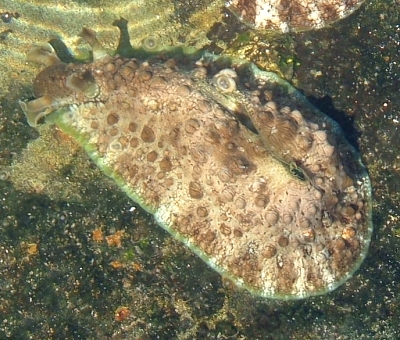
Dear Deb,
This is Dolabrifera brazieri. It is indeed a Sea Hare but unlike species of Aplysia, the parapodia are much reduced. In many ways they can be considered the 'limpets' of the Sea Hare family, usually found in intertidal, or shallow water, and like limpets their streamlining seems designed to protect them from being washed off by the forces of breaking waves.
Have a look at the species Fact Sheet which will guide you to general information on Sea Hares.
Best wishes,
Bill Rudman
Dolabrifera brazieri from eastern Victoria
February 7, 2007
From: John Eichler
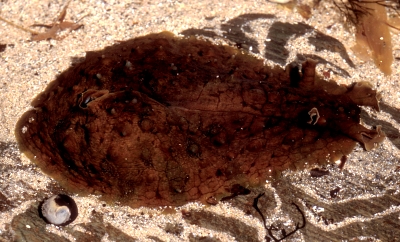
Dear Bill
I thought this photograph of a dark brown coloured Dolabrifera brazieri might be of interest since the other images on the Forum show mottled animals. It was one of three specimens (the other two were mottled) observed at Cape Conran in February 2006, and follows the discovery of a single specimen there a year earlier (see message #13766 ). Egg ribbons were also observed in February 2006. Is it reasonable to assume that the species is established at Cape Conran? These records appear to represent a range extension from southern NSW - based on advice from Museum Victoria and local expert, Bob Burn and the lack of any posted responses to your 2005 request for other Victorian observations.
Locality: East Cape, Cape Conran, intertidal, Victoria, Australia, Bass Strait, 26 February 2006, Rocky intertidal (mudstone). Length: About 130 mm. Photographer: John Eichler.
Regards
John Eichler
john.eichler@frankston.vic.gov.au
Eichler, J.G., 2007 (Feb 7) Dolabrifera brazieri from eastern Victoria. [Message in] Sea Slug Forum. Australian Museum, Sydney. Available from http://www.seaslugforum.net/find/19381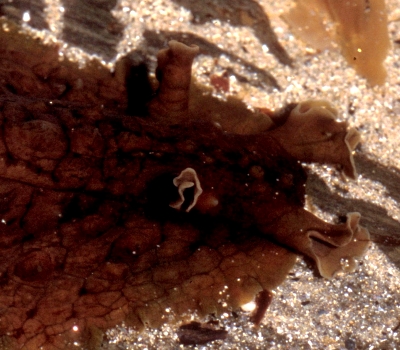
Dear John,
The brown colour of your animals certainly makes me wonder if in this species colour pigments from their algal food is being incorporated in their skin. As this species seems to survive quite well in aquaria it would be a nice little project for someone - but the first step would be to find out which algae it does eat.
Concerning your question about whether this species is established at Cape Conran. I suspect this is the southern extreme of its range and its occurrence is dependent on planktonic larvae arriving from further north at an appropriate time. In Sydney we sometimes have great populations of the tropical Chelidonura inornata and C. fulvipunctata, but they are there for a few months and then disappear. I wouldn't describe them as 'established species'. The concept of 'established species' is more appropriate for terrestrial species and marine species in which the offspring and parent populations are found together. In marine species with free-swimming larvae, the parent population is often far away from the juveniles.
Best wishes,
Bill Rudman
Dolabrifera brazieri from New South Wales
January 23, 2007
From: Krista Rankmore
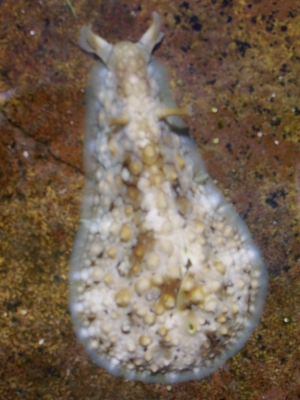
Hi Bill,
I am having trouble identifying this species found on the Central Coast, New South Wales. It was found in a small rock pool on the high intertidal zone. I have looked at Berthellina citrina, Pleurobranchaea maculata and other similar species but have not found anything like it. Image one and two show the species and image 3 shows the location it was located.
Locality: Little Beach, Central Coast, intertidal, New South Wales Australia, Pacific Ocean, 20/01/2007, Intertidal. Length: 11cm. Photographer: Daniel Hawkins.
Thankyou for your help.
Krista Rankmore
krista.rankmore@hotmail.com
Rankmore, K.R., 2007 (Jan 23) Dolabrifera brazieri from New South Wales. [Message in] Sea Slug Forum. Australian Museum, Sydney. Available from http://www.seaslugforum.net/find/19284Dear Krista,
Fortunately I could identify it from your first photo, because the other two photos are of you? and your friends having what looks like a very good party! I guess you chose the wrong files when you uploaded them. I assume you didn't want me to post your 'happy hour' to the world.
Your animal is a Sea Hare, Dolabrifera brazieri. Have a look a the species Fact Sheet for information about it and links to other information on Sea Hares
Best wishes,
Bill Rudman
Dolabrifera brazieri with opaline gland secretions
September 14, 2005
From: Sascha Schulz
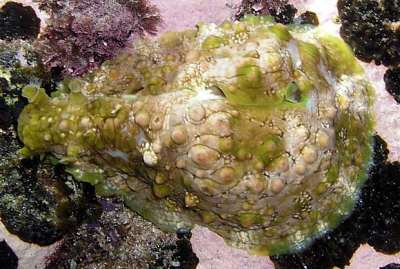
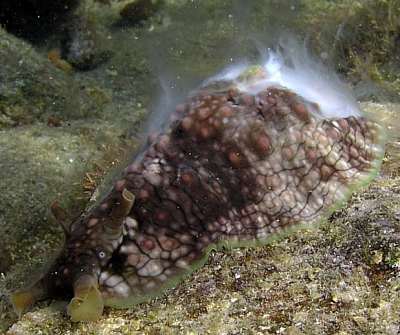
Dear Bill,
I found these at Wollongong, NSW, eastern Australia in July 2005 I guess they are the same species. The upper one is from 2 m at Bass Point, and the lower one from a rockpool . It emitted the white cloud after being touched.
Sascha Schulz
ss31@dodo.com.au
Schulz, S., 2005 (Sep 14) Dolabrifera brazieri with opaline gland secretions. [Message in] Sea Slug Forum. Australian Museum, Sydney. Available from http://www.seaslugforum.net/find/14761Dear Sascha,
These are Dolabrifera brazieri, a large species of Dolabrifera which appaers to be endemic to southeastern Australia and northern New Zealand. I am a bit hesitant to say much about the white milkly secretion in your photo. As I discuss on a Fact Sheet, sea hares produce a variety of secretions from glands in their mantle cavity. This spectacular milky white secretion is from the opaline gland. Its function is unknown.
Best wishes,
Bill Rudman
Dolabrifera brazieri from Victoria, Australia
May 13, 2005
From: John Eichler
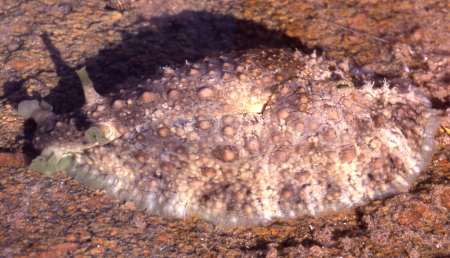
Dear Bill,
I found this large Sea Hare in the shallows at Cape Conran in eastern Victoria earlier this year. It seems to match the description and images of Dolabrifera brazieri posted on the Forum.
Locality: West Cape, Cape Conran, Victoria, Australia. Bass Strait. Depth: Intertidal. Length: About 150 mm. 09 March 2005. Intertidal - In open on rock platform. Photographer: John Eichler
As you can see, its colour and texture resemble the granite rock on which it was found. Is my tentative identification correct and do you know of any other Victorian records?
Thank you for the great web site and stunning images.
Regards
John Eichler
john.eichler@frankston.vic.gov.au
Eichler, J.G., 2005 (May 13) Dolabrifera brazieri from Victoria, Australia. [Message in] Sea Slug Forum. Australian Museum, Sydney. Available from http://www.seaslugforum.net/find/13766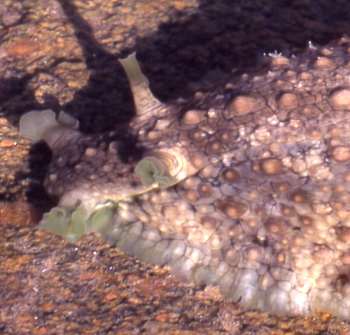
Dear John,
Thanks for the photo. My first thought on seeing the photo, and before reading your message. was how well camouflaged it was against the rocky background. This species is known from New South Wales and nthn New Zealand, and I am pretty sure it has been found in at least eastern Victoria. I have done a quick - definitely not exhaustive - literature search, and can't find a Victorian record. If anyone can let me know of Victorian records I would be grateful
Best wishes,
Bill Rudman
Dolabrifera brazieri from New Zealand
February 21, 2004
From: Ross Armstrong
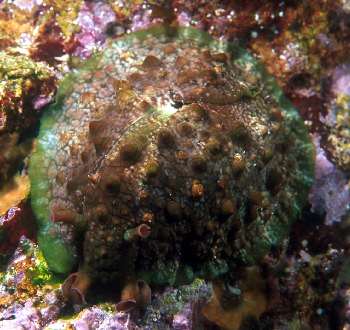
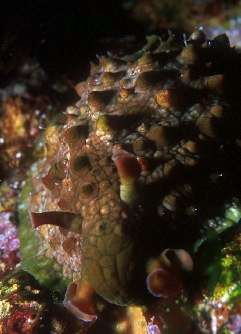
Hi Bill
I found this Sea Hare at the Poor Knights Ids [NE New Zealand] in about 4m. It colouration and texture made it blend in with the rocky reef very well and I struggled to find it again to show it to Diane.
Having looked through your website the only seahare that seems to match is Dolabrifera brazieri.
Kind regards
Ross Armstrong
ross@oceanwildlife.com
Armstrong, R., 2004 (Feb 21) Dolabrifera brazieri from New Zealand. [Message in] Sea Slug Forum. Australian Museum, Sydney. Available from http://www.seaslugforum.net/find/12260Dear Ross,
Yes this is Dolabrifera brazieri. Although quite large, its excellent camouflage, matching the background algal growths remarkably well, makes it very difficult to see. It is has been reported from northeastern New Zealand before as either Dolabrifera brazieri or Dolabrifera dolabrifera, which is the small tropical species.
Best wishes,
Bill Rudman.
Dolabrifera brazieri from Lord Howe Island
April 26, 2003
From: W.B. Rudman
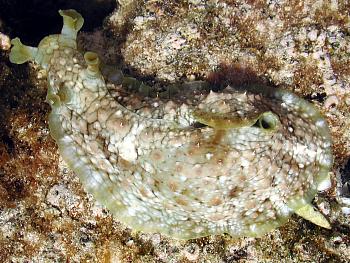
Here is a photo record from Ian Hutton of Dolabrifera brazieri from Neds Beach, Lord Howe Island.
The mottled colour pattern of browns, pinks and greens match the colour of the rock platform on which it lives. The lower photo, of the openings into the mantle cavity also show the partially retracted white filaments at the tip of each tubercle.
Bill Rudman

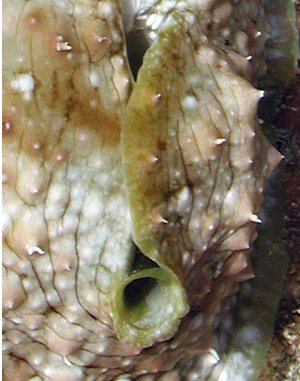
Dolabrifera brazieri from Lord Howe Island (2)
April 26, 2003
From: W.B. Rudman
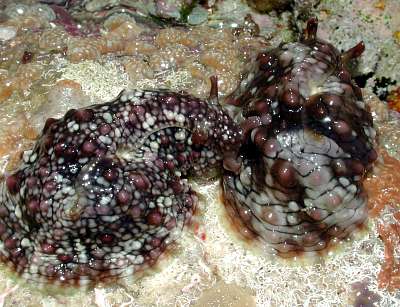
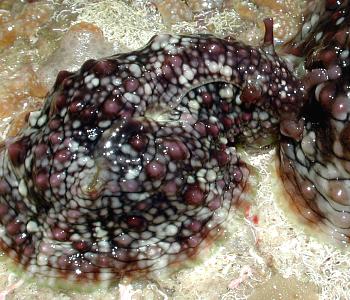
Here is another photo record from Ian Hutton of Dolabrifera brazieri from Neds Beach, Lord Howe Island.
These two animals have a very unusual dark brown and pink colour pattern.
Bill Rudman
Dolabrifera brazieri from Swansea, eastern Australia
April 26, 2003
From: Simon Voorwinde
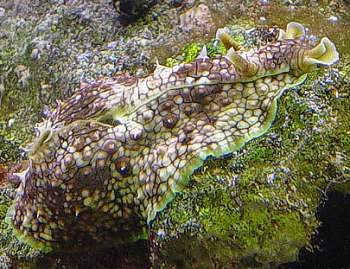
This is a sea hare that I caught in a tidal pool at Swansea, New South Wales, Australia, late December 2002.
The rock pool was dominated by macroalgae such as Ulva sp. and various brown macroalgae. The rock pool was strewn with boulders with scattered patches of sandy bottom. At the bottom of the tide the pools are no more than 30cm deep. At high tide the region is a very high flow zone covered by more than a metre of water.
It was collected to become part of my algae clean-up crew in my marine aquarium and so far it has proven itself to be hard working on a range of filamentous green algae, cyanobacteria, and diatoms. It seems to change colour according to the type of algae it is eating the most of. At the moment it is a dark reddish colour as diatoms and cyanobacteria seem to be making up a large part of its diet.
I assume it is an Aplysia sp. but I have not found anything here that really matches it and I am very interested in positively IDing it. Shortly after it was added to the aquarium it laid hundreds of rows of pinkish eggs over an internal powerhead pump. As there is only one individual in the tank I assume the eggs would not be fertile, however, over the next few days I hope to find one or two more to add to the tank so should this happen again, is there any chance the eggs could hatch and survive in an aquarium? I have read that in some sea slugs there is a commensal relationship between algae and the animal, or they may contain photosynthetic cells in their bodies. Is this where the individual in this photograph gets its green colouration from? It is in a 340L tank (3x2x2ft) with a 250w 10,000K metal halide light over it and it seems to spend a lot of time high up in the tank to increase its exposure to the light.
If you should find a use for this photograph you are more than welcome to use it. It is taken in the aquarium on liverock grazing on green filamentous algae.
Regards,
Simon
svavevav@idx.com.au
Dear Simon,
Your animal is a Sea Hare, but not an Aplysia. It is Dolabrifera brazieri, a species found only in eastern Australia. I have suggested before that it would make good little glass cleaner in an aquarium, so I am glad to see its living up to expectations. I am very interested to hear your suggestion that it appears to change colour depending on the colour of the algae it is eating. I have had my suspicions about it changing colour because it is always very well matched to the colour of its surroundings. It is certainly something worth following up.
Concerning 'solar powered' sea slugs. I don't know of any Sea Hare which does this. If they are matching the colour of the algae, then I guess they are doing it through incorporating algal pigments in their skin, rather than incorporating plant plastids.
Thnaks for your message. I previously had this species and the tropical Dolabrifera dolabrifera together on one page. It was a job I was leaving until I had a moment to spare. Your message has forced me to split them into two pages, and as I thought it took a lot longer than a moment!
Best wishes,
Bill Rudman
Dolabella brazieri from northern New South Wales
April 26, 2003
From: Bill Rudman
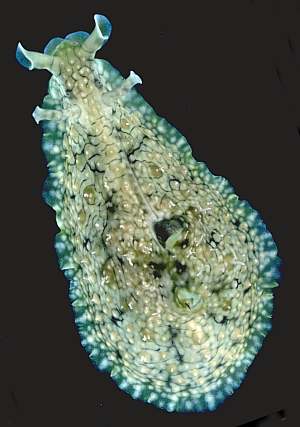
Here are some photos of another Dolabrifera brazieri from northern New South Wales.
Coffs Harbour, nothern New South Wales, December 1990. 3cm long alive. AM C164486. Photos: Bill Rudman.
The lower left photo shows the branching filament at the tip of each of the large tubercles. Often this filament is retracted into a terminal pore. This is almost always the case in preserved specimens and explains why specimens of this species and Dolabrifera dolabrifera are often described as 'smooth'.
The lower right photo shows the opening into the mantle cavity through the partially fused parapodia. The groove in the top left corner is the external sperm groove which carries the animal's sperm forwards to the penis which sits retracted on the right side of the head. In the bottom right of the photo there is a large opening, which is the exhalent siphon discharging water from the mantle cavity. Inside this siphon there is a smaller tube with a black line emerging from it. The tube is the anus and I think the black line is a bit of waste being discharged.
Best wishes,
Bill Rudman
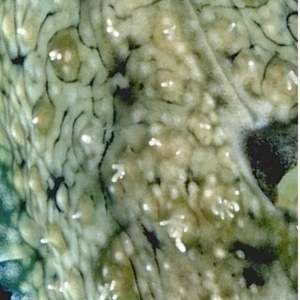
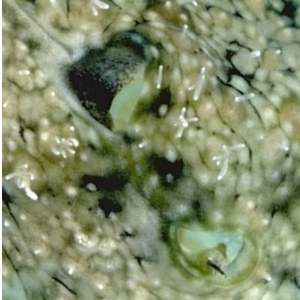
Dolabella brazieri from southern New South Wales
April 26, 2003
From: Bill Rudman

Here are some photos of Dolabrifera brazieri from southern New South Wales.
Two-Fold Bay, southern New South Wales, eastern Australia. March 1986 AM C149561. [animals ranged from 10-15cm long] Lower Left: showing head, Lower Right: showing opening into reduced mantle cavity. Photos: Bill Rudman
These photos illustrate a fairly typical specimen. It is much broader and flatter than a species of Aplysia and the relative large foot helps it to fasten firmly on to the rocky substrate. I guess it is the nearest thing to a 'limpet' within the Sea Hares. One of the most noticeable modifications is the fusing of the parapodia, except for a small gap. This makes a permanent 'parapodial chamber' which encloses the reduced shell and associated mantle cavity. The free part of the parapodial edge [lower right photo] forms a pair of valves and siphons which direct water in and out of the mantle cavity.
Best wishes,
Bill Rudman


Dolabrifera dolabrifera & D. brazieri
April 26, 2003
From: Bill Rudman
Today I am posting a series of messages, and Fact Sheets on Dolabrifera dolabrifera and Dolabrifera brazieri. D. brazieri is endemic to the subtropical and temperate eastern coast of Australia, in particular the coast of New South Wales. I have had it on the Forum as 'the NSW form' of D. dolabrifera because I suspected we would probably find intermediates between it and the common tropical D. dolabrifera but never have. I have been meaning to make a page for D. brazieri for some time and Simon Voorwinde's recent query means I can delay no longer.
Best wishes,
Bill Rudman
